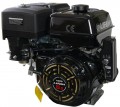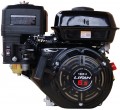Power
The rated power of the engine in horsepower (in fact,
the maximum power that the unit can produce in normal operation, without overloads). Despite the popularity of the designation in watts (see below), horsepower (hp) is still quite widely used to indicate the power of internal combustion engines. 1 HP is approximately 735 watts.
In general, the more powerful the engine, the more speed and tractive effort it is able to develop. On the other hand, this indicator directly affects the weight, dimensions, and most importantly, the cost of the unit, while the real need for high power is relatively rare. Therefore, it is worth choosing according to this indicator, taking into account the features of the planned application; specific recommendations on the selection of an engine for a specific technique and tasks can be found in special sources. We only note that models of the same power can differ in speed and "torque"; see "Shaft speed" for details.
In general, performance up to 8 hp. are considered low, up to 13 hp. — medium, more than 13 hp — high.
Power
The rated power of the engine (the highest power it can deliver in normal operation) in kilowatts. Initially, the power of internal combustion engines (ICE) was usually denoted in horsepower, but now it is also common to record in watts / kilowatts; this, in particular, makes it easier to compare the power of internal combustion engines and electric motors. Some units can be converted to others: 1 hp approximately equal to 0.735 kW.
In general, the more powerful the engine, the more speed and tractive effort it is able to develop. On the other hand, this indicator directly affects the weight, dimensions, and most importantly, the cost of the unit, while the real need for high power is relatively rare. Therefore, it is worth choosing according to this indicator, taking into account the features of the planned application; specific recommendations on choosing an engine for a specific technique and tasks can be found in special sources. We only note that models of the same power can differ in speed and "torque"; see "Shaft speed" for details.
Max. torque
The maximum torque developed by the engine during operation. Note that such an indicator is usually achieved only at certain speeds — this nuance can be specified in the characteristics.
Torque can be simplistically described as the force exerted by a motor on a shaft. The higher this effort, the more “high-torque” the motor is, the better it overcomes resistance and handles with high loads. The torque value is directly related to the power. For example, for 5 hp models. and less torque
up to 10 Nm is considered quite normal, engines of 4 – 7 hp. give out
from 10 to 20 Nm, and values
of 20 Nm or more are found in units with a power of at least 8 hp. At the same time, engines of the same power may differ in actual force. So this indicator characterizes the capabilities of the unit well in comparison with analogues.
It is worth saying that many consider torque to be a more reliable and visual parameter than power: the latter can be indicated in different ways (nominal, maximum, etc.), while torque is a completely unambiguous characteristic.
Shaft diameter
The diameter of the motor shaft, more precisely, the diameter of its outer part, located behind the housing. Data on the diameter of the shaft is needed to clarify the compatibility of the engine with the mechanism for which it is bought.
Now on the market there are shafts with the following diameters:
16 mm,
19 mm,
20 mm,
22 mm,
25 mm.
Capacity
The working volume of all engine cylinders. Usually, other things being equal, a larger volume allows you to achieve higher power, but increases fuel consumption and affects the dimensions of the unit.
Compression ratio
The compression ratio provided by the engine.
The compression ratio is the ratio of the total volume of each cylinder (above-piston space at the extreme lower position of the piston) to the volume of the combustion chamber (above-piston space at the extreme upper position of the piston). Simply put, this parameter describes how many times the over-piston space decreases when the piston moves from the bottom to the top.
A higher compression ratio, on the one hand, contributes to an increase in engine efficiency and allows you to achieve more power (compared to analogues of the same volume) and lower fuel consumption (compared to analogues of the same power). On the other hand, with an increase in the compression ratio, the likelihood of detonation (“knocking in the engine”) also increases, which puts forward increased demands on the quality of the fuel.
The lowest compression ratio found in modern engines is about 5.6:1, the highest is about 19:1.
Piston diameter
The engine piston diameter is a reference parameter — in fact, this data is required very rarely, usually, for repairs and other specific tasks that the average user usually does not deal with at all.
Piston stroke
The distance that an engine piston travels from one extreme point to another. In general, it is a rather specific characteristic and is rarely required in fact (for most ordinary users, it is never needed at all in the entire “life” of the engine).
Fuel tank volume
The nominal volume of the engine's fuel tank is the maximum amount of fuel that can be safely filled there. Knowing the fuel consumption (see below), it is possible to estimate the operating time of the unit on a single refill by the volume of the tank by dividing the tank capacity by the consumption.
Large fuel tanks, on the one hand, allow you to work for a long time without refueling, on the other hand, they significantly affect the dimensions and weight of the engine. Also note that many models allow refueling "on the go." When choosing a tank volume, manufacturers take into account these points, as well as the “weight category” and the specifics of the engine application.

